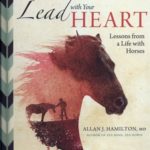
One of the most unexpectedly rewarding experiences of my life has been adopting a little rescue horse. We quickly developed a strong bond that has helped us successfully complete two endurance rides together just three months after I brought him home.
This story begins in mid-July, when Sandra Fretelliere posted on Facebook that her endurance horse’s dam might end up at a slaughterhouse. Barb Horstmeier in Fort Valley, Virginia, agreed to adopt the mare from the Pennsylvania rescue where she was being held. Checking videos of other horses at the rescue, Barb noticed a small, Arabian gelding with a big trot and suggested I take him on as a training project, offering to haul him along with the mare to her place in early August. We were given no information about this horse, not even a name, so I came up with Gryphon, from the mythological beast that is a cross between a lion and an eagle.
I picked up Gryphon on August 5, on my way back from competing my young mare Siena at a ride in West Virginia and after dropping off my 5,000- mile horse Shiloh at his new retirement home. (My husband holds me to a strict two-horse limit at our place outside Richmond, Virginia!)
Barb commented that even with a full pan of feed available, Gryphon first gobbled up a big handful of loose mineral salt. She started giving him limited access to grass so I?d be able to turn him out in my pasture by the time I brought him home. Despite several weeks of regular meals, 14-1 Gryphon was still under 700 pounds when I first saw him, with a raised area on his windpipe and recent scars on his haunches?perhaps from being squashed against a manure-covered wall in the transport trailer? At least his hooves were in good shape, although flared out from lack of care.
Gryphon loaded readily, but even with Siena for company started kicking in fear so I left right away on the three-hour drive home. After turning him out for a few days, I started by haltering and leading Gryphon around to get him used to his new home. He was soon being fed four pounds of high-fat concentrate twice a day, plus loose mineral salts and hoof supplement, with a couple flakes of clover and alfalfa hay tossed out each morning.
I focused on grooming and handling his feet for a few days, putting on and takingoff hoof boots and getting him used to being rubbed everywhere. He especially loved having his ears rubbed and tugged on! I soon added a saddle and bridle and began short lunging sessions. I could tell Gryphon had been trained by the matter-of-fact way he? accepted the equipment, but it took some time and effort to get him to relax and settle on the lunge?he would zoom around as if being chased!
Heeding the advice of friends who warned me not to wait too long, I first sat on Gryphon?s back after he?d just been at my place 10 days. We took a few steps around the paddock, then I dismounted and remounted one more time before quitting for the day. For those first short rides, he was still so narrow that I used two thick saddle pads and my smallest girth, gradually increasing the amount of trotting. Although he didn’t like crossing water, I could tell Gryphon really enjoyed being out on trail. There were some challenges, however. As he gained fitness and energy, he would weave nervously while being tacked up. On two occasions, he jerked back on the lead rope and struggled to pull free. The halter and lead held fast, so after he settled down I was able to continue. Using a soft, reassuring voice and feeding a piece of carrot at each step of the process helped his acceptance.
Gryphon needed to be re-schooled on trailer loading as well, so I began feeding him in the trailer stall to reinforce his thinking as a ?home away from home.? By early September, we began traveling to nearby trails as he continued adding weight and building muscle. One trip involved taking my rig on the ferry across the James River.
Gryphon kept his head out with curiosity the whole way across!
By early October, Gryphon was up to about 25 miles of riding a week. When he floated Gryphon?s teeth, my vet confirmed he was about 7 years old and reassured me that the windpipe scar should not affect his ability to handle the rigors of endurance. The hoof boots I had been using didn’t stay on as well once we started doing longer and faster training rides, so he got his first pair of shoes in mid-October and I noticed an immediate improvement in his stride.
Eager to see how my little rescue horse would handle an actual endurance ride, I hauled my two horses to South Carolina for the Sand Hills 35-mile LD ride on October 20. My friend Teresa McCarty rode Siena as a companion horse and was a big help before the ride and the vet checks. In base camp, Gryphon never stopped eating his hay and pan of beet pulp mixed with grain.

On ride day, he boldly led the way out on trail while Siena followed close behind. The first loop was nearly 25 miles, so we packed electrolytes, grain and carrots and took a rest stop beside a big puddle about halfway through, which helped ensure good vetscores at the first hold. On the second loop, Siena led most of the way to help us keep a consistent pace. Several frontrunners missed a turn, so we ended up in third and fourth place with a ride time of 4:36. After watching his completion trot-out, timer Laurie Underwood commented that Gryphon looked as if he?d been doing endurance all his life!
Three weeks later, Gryphon tackled his first 50 at Broxton Bridge, also in South Carolina. This was a longer trip and we didn’t arrive until nightfall, but he ate well overnight. On ride day, he was excited while being tacked up since he knew what to expect ?but once I was on board, trotted calmly out of camp and kept pace with the big gelding Amy Atkins was riding (Siena was in the LD ride). Without his buddy horse at the first hold, he wouldn?t settle and eat until I stayed with him and hand-fed. When I was trying to electrolyte and finish retacking, Don Meuten, DVM, happened to pass by and was a big help, teaching me how to do a nose twitch when all else fails!
At the second hold, Gryphon ate much better. He stopped for a long drink of water about halfway through the last loop, and when I asked him to pick back up the trot noticed he was favoring his right front leg a bit. Concerned he might be going lame, I dismounted and hand-walked him for about a mile after checking his hooves and the saddle. He perked up as we started ap-proaching camp (like most horses, he has a great sense of direction), so I remounted and when another rider caught up to us, asked her to watch his trot. He was moving better and we trotted slowly in the last few miles.
The ride vets saw a few bad steps on Gryphon?s completion trot-out, so Dr. Ken Marcella offered to examine him later that afternoon. Using flexion tests and histhermography machine, Ken pinpointed Gryphon?s right front fetlock joint as the source of the issue. The next morning, that joint was slightly swollen compared to the left front so I iced it several times that day and the next. By the time I got home from work on Monday, both ankles were the same size and Gryphon was sound and happily running around the pasture. His hoof walls have grown out so much that in another few farrier visits, his feet will be back to their normal shape, which should help him stay sound, plus he’ll be getting a joint supplement before next ride season.
I was extremely fortunate to take on a rescue horse that happened to have been well-trained at some point, and also credit Barb?s eye for picking a horse welll suited for endurance. Gryphon does have some skeletons in his closet, and a few times I had to pep-talk myself before going out to work with him. What kept me going was the grateful look in his eyes when things were going well and knowing how much fun we?d have once out on trail. My plan is to continue competing him in 2013 and one day tackle a 100. Gryphon has become a friend that I?d want to spend that many miles and hours with!
Some Tips for Rehabbing a Rescue Horse
1. Do something with your rescue horse every day to help develop trust more quickly.
2. Be careful about how much you feed at one time . . . the rescue facility and my friend Barb got Gryphon to the point where he could handle both grass and larger amounts of concentrate, but I still upped his grain ration gradually and waited a few weeks before worming to ensure his system could handle this.
3. Take your time finding out how much training the horse has had and what his issues are (there will likely be some!). Focus on one thing at a time, letting other issues wait for another day.
4. Practice key skills like loading and standing tied many times at home so that out in public there are fewer surprises.
5. Use your voice to reassure and reward as well as reprimand. I’ll never forget how Gryphon?s ears pricked up when I praised him for crossing the creek behind my house without acting up beforehand! When I use my stern voice, however, he knows I mean business.
6. Once the basics are set, switch your routine so the horse never knows what to expect! Don?t ride every time you fetch him from the field; lunge on days when you don’t have time to ride.
7. Ride alone if you are comfortable doing this. Real bonding comes from gaining confidence in how your horse handles situations by himself. This also prepares you if a buddy horse is not able to continue at an endurance ride. Always wear a helmet and tell someone where you are going!
8. With help from your veterinarian and farrier, constantly evaluate your feeding and hoof care regimens and make adjustments as needed. Using the scales at the Sand Hills ride, I found out Gryphon weighed 756 pounds; my goal is to add another 100 pounds and do more training on hills before his next ride in 2013.
9. Expect some setbacks and be creative in resolving them. I’m giving Gryphon syringes of applesauce to practice for the next time he needs to be electrolyted.
10. Have faith that things will work out. I rationalized taking on this unknown risk by telling myself, ?Well, I can always find someone to give him to if he doesn’t work out.? I’m thrilled that he enjoys endurance, because it might have been a challenge to find him another good home!







